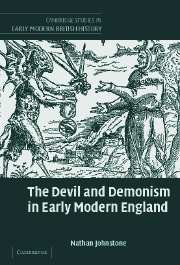Book contents
- Frontmatter
- Contents
- Acknowledgements
- 1 Introduction
- 2 The synagogue of Satan: anti-Catholicism, false doctrine and the construction of contrariety
- 3 Temptation: the Protestant dynamic of diabolic agency and the resurgence of clerical mediation
- 4 Satan and the godly in early modern England
- 5 Incarnate devils: crime narratives, demonisation and audience empathy
- 6 ‘What concord hath Christ with Belial?’: de facto satanism and the temptation of the body politic, 1570–1640
- 7 ‘Grand Pluto's Progress through Great Britaine’: the Civil War and the zenith of satanic politics
- 8 ‘The Devil's Alpha and Omega’: temptation at the cutting edge of faith in the Civil War and the Interregnum
- Conclusion
- Bibliography
- Index
- Cambridge Studies in Early Modern British History
3 - Temptation: the Protestant dynamic of diabolic agency and the resurgence of clerical mediation
Published online by Cambridge University Press: 23 June 2009
- Frontmatter
- Contents
- Acknowledgements
- 1 Introduction
- 2 The synagogue of Satan: anti-Catholicism, false doctrine and the construction of contrariety
- 3 Temptation: the Protestant dynamic of diabolic agency and the resurgence of clerical mediation
- 4 Satan and the godly in early modern England
- 5 Incarnate devils: crime narratives, demonisation and audience empathy
- 6 ‘What concord hath Christ with Belial?’: de facto satanism and the temptation of the body politic, 1570–1640
- 7 ‘Grand Pluto's Progress through Great Britaine’: the Civil War and the zenith of satanic politics
- 8 ‘The Devil's Alpha and Omega’: temptation at the cutting edge of faith in the Civil War and the Interregnum
- Conclusion
- Bibliography
- Index
- Cambridge Studies in Early Modern British History
Summary
A child brought to be baptised in 1548 underwent a lengthy ritual of exorcism in which the Devil was driven out by the mediation of the priest and the efficacy of the holy artefacts used in the rite. Through baptism the child entered the church; Satan was denied ownership of his soul, and was publicly forbidden to trouble the infant further. Four years later, a child baptised under the second of the reformed Edwardian prayer books took part in a very different ceremony. There was no longer an exorcism to provide a tangible victory over the demonic. Instead the signing of the cross and the promise to renounce the Devil were taken as an indication that the new Christian's life was to be characterised by a constant struggle with the demonic. This was a fundamental shift in the demonological rationale of Christian initiation, and one which reflected the Protestant belief that Satan constantly afflicted mankind on earth, and that the pursuit of godliness depended on a rigorous defence against his attempts to lure or drive men from their faith.
Traditionally the Devil's assaults were a frightening possibility, but one which might never be realised. Catholic theology laid a quasi-dualist emphasis on Satan's power, and saw humankind as the trophies of his cosmic battle with Christ.
- Type
- Chapter
- Information
- The Devil and Demonism in Early Modern England , pp. 60 - 106Publisher: Cambridge University PressPrint publication year: 2006



